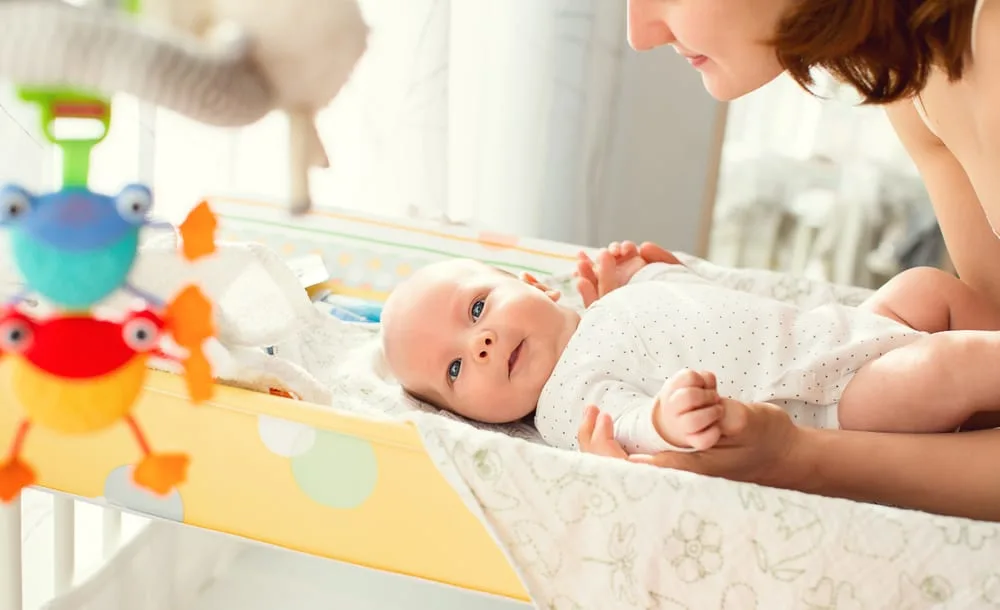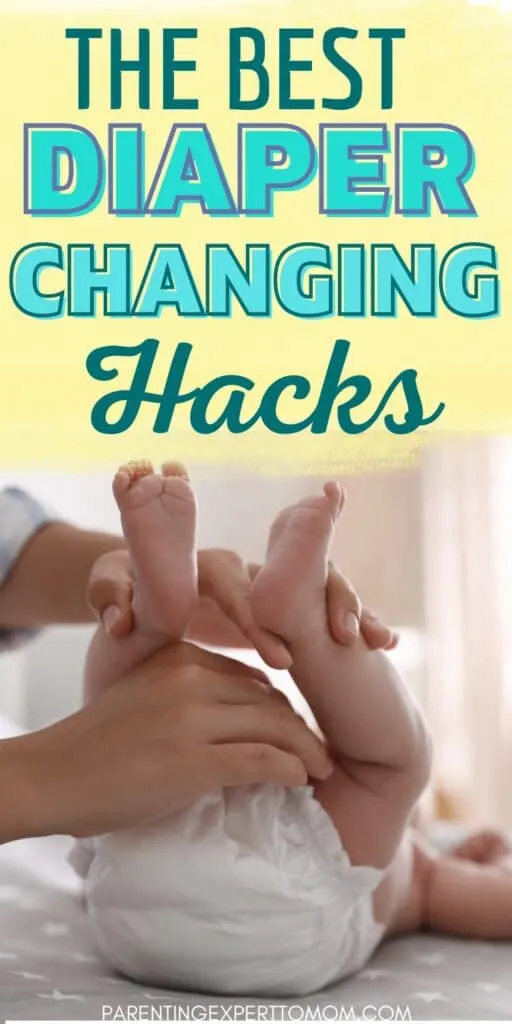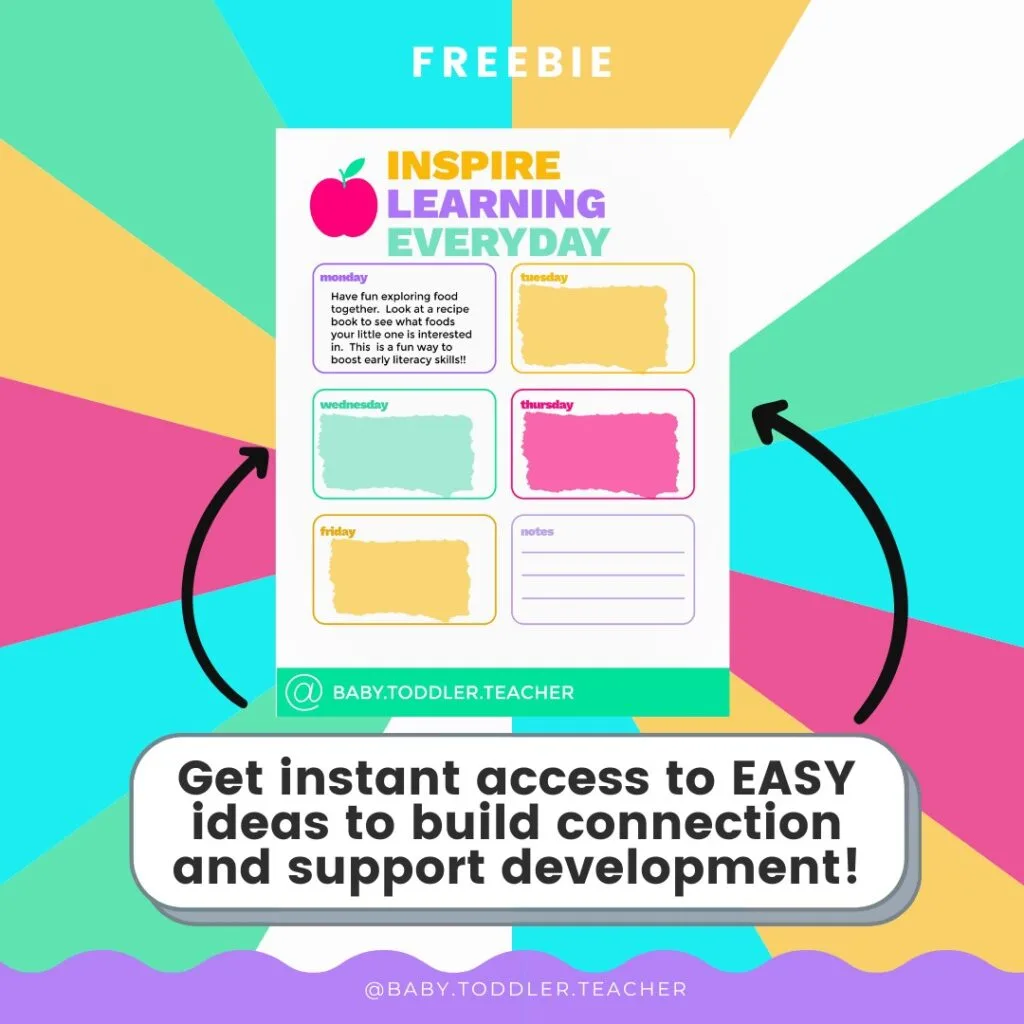When it comes to parenting, every task can potentially become a power struggle, including the seemingly simple act of changing a wet diaper.
Whether it’s a poopy diaper or just a wet one, many parents find themselves in an unexpected battle when trying to get their little one into a clean diaper.
If you’re facing this challenge, you’re not alone!
This article aims to turn the ordeal of diaper changing from a stressful tug-of-war into a positive experience for both you and your baby.
We’ll explore the best ways to keep your baby calm and cooperative during diaper changes, making them less about confrontation and more about connection.
(This post may contain affiliate links. To read our full disclosure policy click here.)

Why Does My Baby Hate Diaper Change Time?
The main reason behind a baby’s aversion to the diaper change process could be as simple as discomfort, especially if they’re dealing with a painful diaper rash.
The cold wipes commonly used can be a shock to their delicate skin, making an already unpleasant situation even more distressing.
Another factor to consider is overstimulation.
While lying on the changing table, a baby might feel overwhelmed by the bright lights above them and the flurry of activity.
It’s important to remember that during a diaper change, little ones feel they have little control over what’s happening, which can be quite unnerving for them.
The good news is that understanding these possible reasons can help you transform the dirty diaper ordeal into a more manageable, less stressful experience for both you and your baby.

How to Make a Nappy Change Less Stressful
Here are our top tips to help transform the diaper-changing experience into something enjoyable, rather than a chore:
- Warm wipes: This might seem like a small change, but it can make a world of difference for your baby. Instead of using cold wipes that can be a shock to your baby’s sensitive skin, try warming them in your hands for a few moments before using them. The warm wipes can comfort your baby and make the change less jarring.
- Dim lights: Babies can become overstimulated by bright lights, especially when it’s coupled with the hustle of a diaper change. Dimming the lights can help create a more calming environment.
- Comfortable temperature: Make sure the room is at a comfortable temperature. A room that’s too cold can make a diaper change an uncomfortable experience for your baby.
- Organized diaper area: The best thing you can do is ensure everything you need is within reach in your diaper area. Having everything in one place means you can make the diaper change swift and less stressful for both you and your baby.
- Positive tone: Keep a positive tone in your voice. Your baby picks up on your emotions, so keeping a positive tone can help them feel more at ease. Make eye contact with your little one and watch for cues on what they like and also what causes discomfort.
Remember, each baby is different and it may take some trial and error to find what works best for you and your little one. By implementing these suggestions, we hope that diaper changes will become less stressful and more manageable!
Treat Diaper Rash
Preventing and treating diaper rash is vital to improve your baby’s overall experience during diaper changes.
The discomfort from an uncomfortable diaper rash can make an already daunting task more difficult for you and your baby.
Diaper rash often occurs as a result of prolonged contact with urine or stool, which can irritate your baby’s sensitive skin.
Utilizing baby wipes that are gentle on your baby’s bottom can help maintain their skin’s natural pH and prevent irritation.
However, if a diaper rash does occur, treating it promptly is essential.
Remember, every baby’s skin is unique and what works for one might not work for another.
It’s always a good idea to consult your pediatrician to find the best option for your little one.
They can guide you through various products tailored to your baby’s specific needs and help ensure that diaper changes become a more pleasant experience for both of you.
Keeping Little Hands Busy: A Fun Approach to Diaper Changes
Adding a playful element into diaper change time can work wonders in keeping your baby relaxed and engaged.
Giving your little one a special toy, fun object, or a soft book to hold onto can be beneficial.
Not only can this make diaper changes more enjoyable, but it also contributes to your baby’s fine motor development.
When your baby is holding onto an object, they are practicing their grip and enhancing their hand-eye coordination.
Additionally, the tactile exploration of different textures – the smooth surface of a rattle, the fluffy exterior of a plush toy, or the crinkly pages of a fabric book – can stimulate their sensory development.
Remember to choose safe, age-appropriate toys that can be easily cleaned, considering they may end up on the changing table.
With this approach, diaper changes become less about fuss and more about fun, transforming a challenging routine into a moment of fun and an opportunity to play!

Foster Connection and Learning During Diaper Time
Diaper changes provide a unique opportunity for new parents to connect with their children and stimulate their learning.
Singing songs and nursery rhymes like “Twinkle Twinkle Little Star” can transform the experience from a routine chore into a fun and learning activity.
Not only does this make the process more enjoyable, but it also contributes to your baby’s cognitive and language development.
As you lay your baby on the changing table, narrate what you’re doing in a calm voice.
This not only reassures them but also helps them understand the process and predict what’s coming next.
During this time, make funny faces at your baby and see if they can imitate you.
This simple interaction is not only fun, but it also encourages early imitation skills which are key to their developmental progress.
Moreover, as you change your baby’s diaper, label the body parts.
This helps improve their listening skills and increases their body awareness.
Take a deep breath and remember that each diaper change is an opportunity to bond and help your little one learn about the world.
So, next time you’re faced with a diaper change, approach it with a positive attitude and see it as a chance to connect and educate, making it a beneficial experience for both of you.

Grab your FREE Milestone Guide HERE.
It will get easier!
Changing the diaper of young babies can often be challenging, but with the right strategies, it can become a smoother, more enjoyable process.
Understanding the most common reasons why a baby may fight diaper changes – from discomfort or overstimulation to a simple longing for control – is the first step in transforming this necessity from a battle into a bonding moment.
Each baby is different, with different needs and reactions, making it essential to approach each diaper change with patience, understanding, and creativity.
Remember, diaper changes are not just about hygiene; they’re a great reason to foster connection, work on new skills, and create a loving environment that aids in your baby’s overall development.
With a positive attitude and consistent application of these tips, diaper changes can become a less stressful and more enriching experience for both you and your baby.
Frequently Asked Questions
There can be several reasons why your baby may suddenly dislike diaper changes. It could be due to discomfort from a diaper rash, overstimulation from bright lights or loud noises, a desire for independence, or simply just being in an uncomfortable position. The key is to identify the root cause and find ways to alleviate it for a more positive experience.
Some strategies to try include creating a calm and comfortable environment, using gentle wipes, maintaining a positive tone, and involving your baby in the process by singing songs or labeling body parts. Each baby is unique, so it may take some trial and error to find what works best for your little one.
Related Posts You Will Enjoy
Fun and Easy Activities for 6-Month-Old Babies
How to Find the Best Activity Table for Your Baby
The Best Books to Read to Your Baby
The Best Social-Emotional Activities for Infants


Kayla O’Neill has a master’s degree in education as well as a bachelor’s degree in special education with an emphasis in early childhood education. She has been working as a developmental therapist with babies and toddlers in early intervention since 2012. She is also a mom with two young children.
